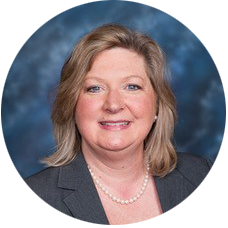When we lose a loved one, our culture often does not understand the importance of grief.
Many feel unspoken pressure to move on quickly. A lot of us might not fully grasp the concept of grief until we experience it for ourselves. Well-known widow Terri Erwin says “Grief is never something you get over. You don’t wake up one morning and say, ‘I’ve conquered that: now I’m moving on.’ It’s something that walks beside you every day. And if you can learn how to manage it and honor the person that you miss, you can take something that is incredibly sad and have some form of positivity.”

The PACE care model treats the whole person, meaning our teams care for each participant’s physical, mental, social, and spiritual health. To better understand how PACE promotes healing across our programs, we connected with Mission Leader, Terry Anderson, to learn about supporting participants and their loved ones through the grieving process.
What does grief support look like within Trinity Health PACE?
Our chaplains and social workers offer deep listening and grief support groups to help participants process significant losses. Chaplains also support anticipatory grief, helping families navigate emotions like fear, sadness, and guilt, and find peace through reconciliation and reflection.
Twice a year, we hold memorial services to honor participants who have passed, allowing our community to grieve together. Chaplains also provide resources for coping on meaningful days like birthdays, holidays, and Veterans Day, and offer one-on-one counseling as needed.
Grief support at PACE is ongoing, compassionate, and deeply rooted in our mission to provide holistic care.
What are other ways team members help those who are grieving?
I work closely with our chaplains and other members of the interdisciplinary team (IDT) on living our Core Values and provide training on what spiritual care should look like within our care model. Three key ways we support our participants include:
- Accompaniment. We prioritize being present with active listening and understand that the pain of grief and loss is not physical pain, but emotional and spiritual pain. We are with them when they come in and with them until they die, and sometimes even beyond. Grief is not in and out, it is ongoing.
- Identifying what matters most to the individual. We help participants identify what their goals are, their values and preferences at end-of-life and ask them what is most important, so they have peace and comfort at end of life.
- The aim of PACE is to encourage connection, socialization, a sense of independence and control over what can be controlled and find meaning and hope and new beginnings even amid losses that occur.
What do a lot of people misunderstand about grief?
Grief is not linear, and there is no ‘right way’ to grieve. For example, some people are emotional grievers, and some are instrumental grievers. Just because someone is not expressing their sadness with tears or emotional expression does not mean they are not processing their grief. Instrumental grievers focus on tasks around the death like planning a funeral or making financial arrangements. This is related to the busyness related to the death and moving forward. They will channel energy into action, think, and analyze, trying to understand what happened, why it happened etc.
The 5 Stages of Grief concept is not a checklist you move through and cross off in order. The stages can overlap, go back and forth, and they do not follow any specific timeline. Grief is individual and each person’s grief is their own and not what others expect.
If a participant is facing tough decisions for their final years or navigating loss of independence, our team seeks to walk with every individual and meet them where they are in their path.
Learn more how our full spectrum of services treats the whole person.
Learn how PACE supports participants in end-of-life conversations and hard decisions. Our Alabama team talks about the importance of planning ahead and facilitating tough conversations.
